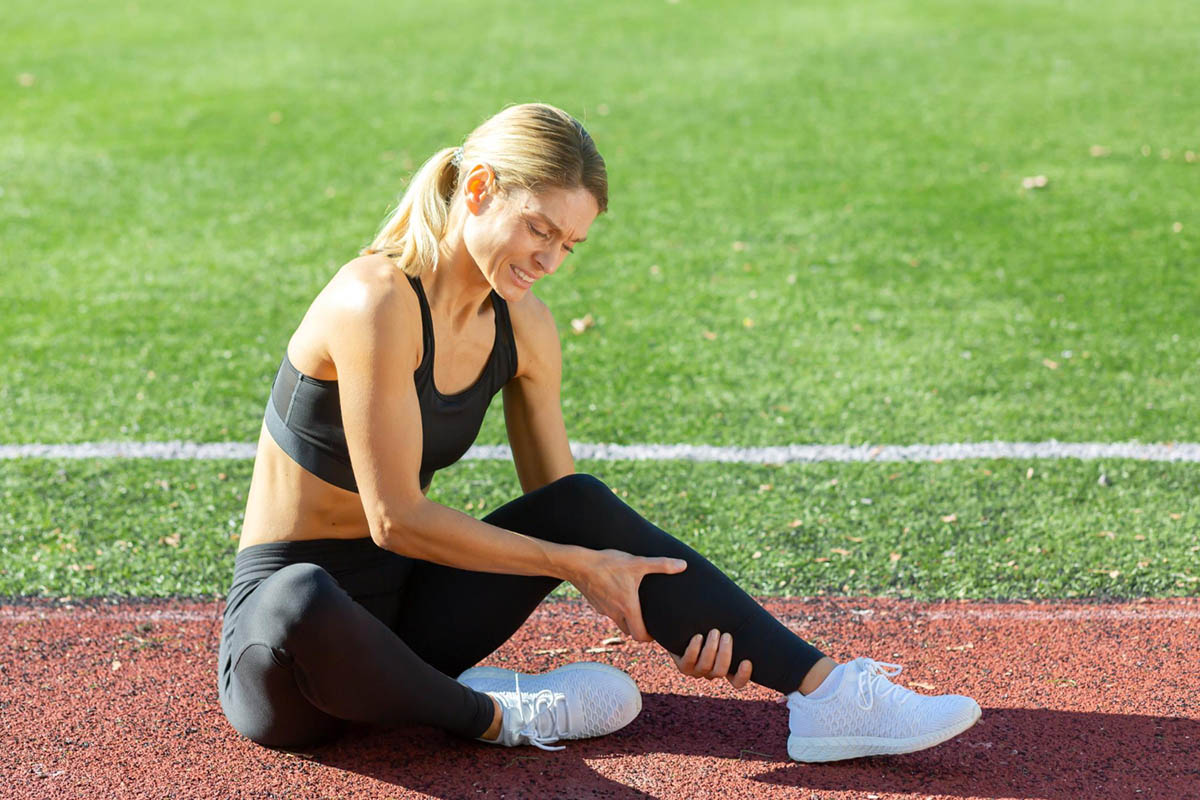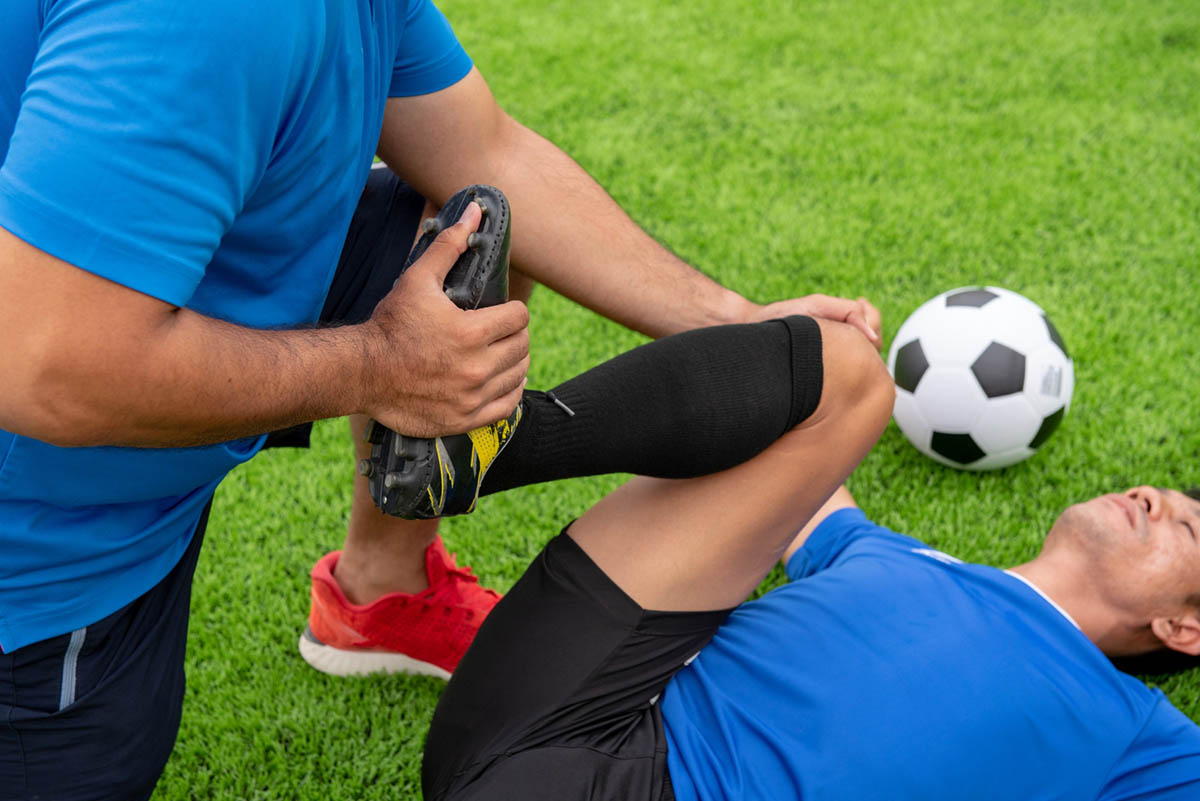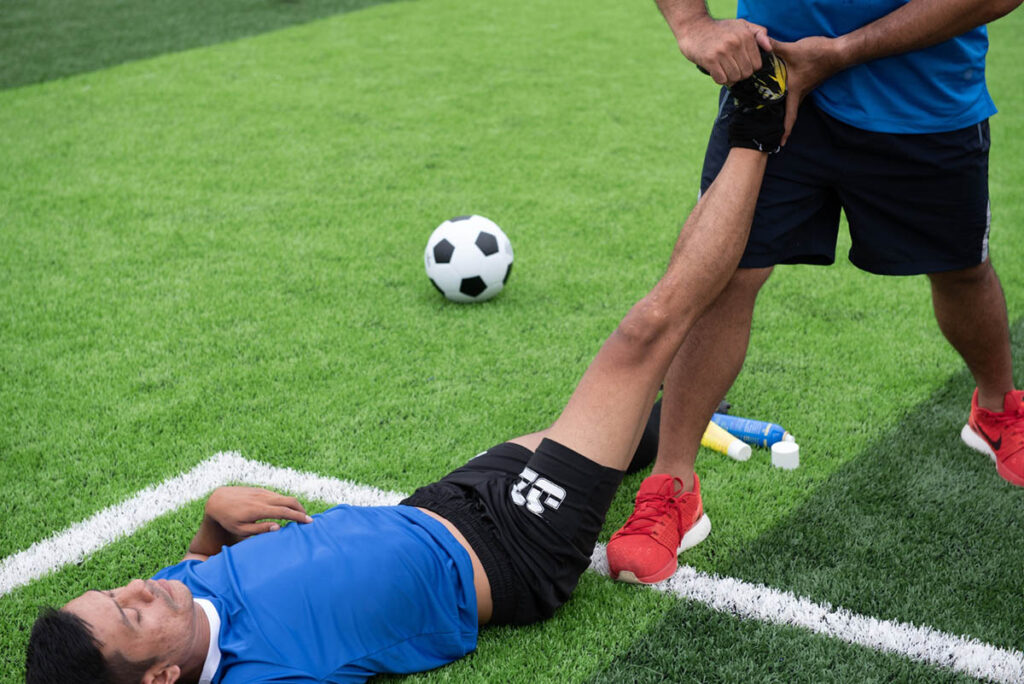Understanding sports injuries is crucial for athletes and fitness enthusiasts alike. Injuries can significantly impact athletic performance and overall health, leading to downtime and long-term complications if not addressed properly. Sports injuries are prevalent, with an annual incidence rate of 5.40 injuries per 100,000 participants. Interestingly, the rate is higher among men (6.44 per 100,000) compared to women (3.34 per 100,000), making knowledge of these injuries an important part of being an athlete. This blog delves into the top 10 most common sports injuries and treatments, offering insights into their definitions, causes, symptoms, and prevention strategies. By familiarizing yourself on what are the top 10 most common sports injuries, you can take proactive steps to minimize your risk for injury and stay active and healthy.
1. Knee Injuries
Knee injuries are among the top 10 most common sports injuries, particularly affecting athletes in high-impact sports like soccer and basketball. These injuries, which can range from mild sprains to severe ligament tears, account for 41% of all sports-related injuries. This high incidence highlights the critical need for effective knee injury prevention and treatment strategies.
Definition:
Knee injuries encompass various conditions such as ligament tears (ACL, MCL), meniscus injuries, and patellar tendinitis. These are common knee injuries that can affect the stability and function of the knee joint and are considered to be one of the most common joint injuries.
Common Causes:
Sudden changes in direction, improper landing techniques, and direct impact during contact sports. Overuse injuries are also a frequent cause, particularly in sports requiring repetitive knee motions.
Symptoms:
Pain, swelling, instability, and difficulty bearing weight on the affected knee. Symptoms can range from mild discomfort to severe pain that requires medical attention.
Treatment:
Rest, ice, compression, elevation (RICE), physical therapy, and in severe cases, surgical intervention. Anti-inflammatories can help reduce swelling and pain, and a physical therapist can assist with rehabilitation exercises to restore strength and mobility.
Prevention:
Strengthening the muscles around the knee, proper warm-up and cool-down routines, and using appropriate footwear and protective gear. Proper stretching and avoiding sudden, intense movements can also reduce the risk of knee sprains and other knee injuries.
2. Ankle Sprain
Ankle sprains are a common type of injury among athletes, often occurring due to sudden twists or turns during physical activity. The incidence of ankle sprains has risen significantly, with approximately 25,000 sprains occurring daily. In the United States, 7 out of 1,000 people will experience an ankle sprain. Ankle sprains constitute 40% of all ankle injuries, and about 45% of basketball players suffer from them, with soccer and football players also frequently affected.
Definition:
An ankle sprain occurs when the ligaments supporting the ankle stretch or tear. This type of injury can vary in severity from a mild sprain to a severe ligament tear.
Common Causes:
Twisting the ankle, sudden changes in direction, and uneven surfaces. Athletes in sports like basketball and soccer are particularly prone to this injury.
Symptoms:
Pain, swelling, bruising, and limited range of motion. Severe sprains may also involve difficulty walking or bearing weight on the affected foot.
Treatment:
RICE, bracing, and rehabilitation exercises to restore strength and flexibility. In severe cases, medical treatment may be necessary, including physical therapy to ensure proper healing.
Prevention:
Strengthening exercises for the ankle, balance training, and wearing supportive footwear. Proper stretching and avoiding uneven surfaces can also help prevent ankle sprains.
3. Tennis Elbow

Tennis elbow, or lateral epicondylitis, is a common overuse injury affecting athletes who engage in repetitive arm movements.
Definition:
Tennis elbow is an inflammation of the tendons that join the forearm muscles to the outside of the elbow. This condition is often seen in athletes who perform repetitive motions, such as tennis players.
Common Causes:
Overuse of the forearm muscles, repetitive motions, and poor technique in sports or activities. Sports involving repetitive arm movements, such as tennis and golf, can lead to this injury.
Symptoms:
Pain and tenderness on the outside of the elbow, weakness in the forearm, and difficulty gripping objects. These symptoms can affect daily activities and athletic performance.
Treatment:
Rest, ice, anti-inflammatory medications, physical therapy, and in some cases, steroid injections. Proper rehabilitation is crucial to prevent recurrence.
Prevention:
Proper technique, strengthening exercises, and using equipment that reduces strain on the elbow. Regular stretching and avoiding repetitive movements can also help.
4. Shoulder Injury
Shoulder injuries are common in many sports, affecting the shoulder joint and surrounding structures such as the rotator cuff.
Definition:
Shoulder injuries can include rotator cuff tears, dislocations, and impingement syndrome. These injuries can significantly impact the shoulder joint’s function.
Common Causes:
Overuse, repetitive motions, and direct trauma to the shoulder. Athletes involved in throwing or overhead activities are at higher risk for these injuries.
Symptoms:
Pain, weakness, reduced range of motion, and instability. Symptoms can vary depending on the type and severity of the injury.
Treatment:
RICE, physical therapy, anti-inflammatory medications, and in severe cases, surgery. A physical therapist can design a rehabilitation program to restore shoulder strength and function.
Prevention:
Strengthening the shoulder muscles, proper technique, and avoiding excessive strain on the shoulder. Regular stretching and avoiding repetitive movements can help reduce the risk of shoulder injuries.
5. Concussion
Concussions are a type of head injury commonly seen in contact sports, requiring immediate attention to prevent long-term effects.
Definition:
A concussion is a mild traumatic brain injury caused by a blow to the head or body that shakes the brain inside the skull. This type of injury can affect brain function temporarily.
Common Causes:
Falls, direct blows to the head, and collisions in contact sports. Sports like football and rugby have a high incidence of concussions.
Symptoms:
Headache, confusion, dizziness, nausea, and memory problems. Symptoms can vary widely and may not appear immediately after the injury.
Treatment:
Rest, monitoring, and gradual return to activity under medical supervision. Proper management is crucial to prevent complications.
Prevention:
Wearing protective gear, using proper techniques, and following safety guidelines in sports. Education on recognizing and responding to concussions is also essential.
6. Groin Strain
Groin strains are common in sports requiring sudden movements and rapid changes in direction, affecting the inner thigh muscles.
Definition:
A groin strain involves a tear or rupture of one of the muscles in the inner thigh. This type of injury can range from a mild sprain to a severe tear.
Common Causes:
Sudden movements, overuse, and inadequate warm-up. Sports like soccer and hockey often involve movements that can lead to groin strains.
Symptoms:
Pain and tenderness in the groin area, swelling, and difficulty moving the leg. Severe strains may also involve bruising and muscle weakness.
Treatment:
RICE, physical therapy, and gentle stretching and strengthening exercises. Anti-inflammatories can help reduce pain and swelling.
Prevention:
Proper warm-up, strengthening the groin muscles, and avoiding sudden, intense movements. Regular stretching can also help maintain flexibility and reduce the risk of groin pulls.
7. Hamstring Strain
Hamstring strains are common among athletes, particularly those involved in running and jumping activities.
Definition:
A hamstring strain is a tear or stretch in the muscles at the back of the thigh. This injury can range from a minor strain to a complete tear.
Common Causes:
Sudden acceleration, overuse, and inadequate flexibility. Sports that involve sprinting or jumping can increase the risk of hamstring injuries.
Symptoms:
Sharp pain, swelling, bruising, and difficulty walking or bending the leg. Severe strains may also involve a noticeable muscle tear.
Treatment:
RICE, physical therapy, and progressive stretching and strengthening exercises. A physical therapist can guide the rehabilitation process to ensure proper healing.
Prevention:
Regular stretching, strengthening the hamstrings, and proper warm-up routines. Avoiding sudden increases in activity intensity can also help prevent hamstring injuries.
8. ACL Injury
ACL injuries are serious knee injuries that can sideline athletes for extended periods, requiring comprehensive treatment and rehabilitation.
Definition:
An ACL injury involves a tear of the anterior cruciate ligament in the knee. This is one of the most severe sports injuries, often requiring surgical intervention.
Common Causes:
Sudden stops, changes in direction and landing improperly from a jump. These movements are common in sports like basketball and soccer.
Symptoms:
A popping sound, severe pain, swelling, and instability in the knee. Immediate medical attention is often required for ACL injuries.
Treatment:
RICE, physical therapy, and often surgical reconstruction. Rehabilitation is crucial to restore knee stability and function.
Prevention:
Strengthening exercises, proper technique, and using supportive footwear. Regular training on proper landing and cutting techniques can also help reduce the risk of ACL injuries.
9. Shin Splints
Shin splints are a common overuse injury affecting runners and athletes involved in high-impact activities.
Definition:
Shin splints refer to pain along the shinbone (tibia) due to overuse. This condition can affect the muscles, tendons, and connective tissue around the shin bone.
Common Causes:
Excessive running, poor footwear, and running on hard surfaces. Shin splints are particularly common among runners and athletes who increase their activity intensity too quickly.
Symptoms:
Tenderness, soreness, and pain along the inner side of the shinbone. Symptoms typically worsen with activity and improve with rest.
Treatment:
RICE, reducing activity, and physical therapy. Proper footwear and orthotics can also help alleviate symptoms.
Prevention:
Gradual increase in activity intensity, proper footwear, and running on softer surfaces. Strengthening the muscles around the shin bone can also help prevent shin splints.
10. Hip Flexor Strain

Hip flexor strains are common in sports requiring sudden movements and explosive actions, affecting the muscles at the front of the hip.
Definition:
A hip flexor strain is a tear or stretch in the muscles at the front of the hip. This type of injury can range from a minor strain to a severe tear.
Common Causes:
Sudden movements, overuse, and inadequate warm-up. Sports like sprinting and martial arts often involve movements that can lead to hip flexor strains.
Symptoms:
Pain in the front of the hip, swelling, and difficulty moving the leg. Severe strains may also involve bruising and muscle weakness.
Treatment:
RICE, physical therapy, and stretching and strengthening exercises. Anti-inflammatories can help reduce pain and swelling.
Prevention:
Proper warm-up, strengthening the hip flexors, and avoiding sudden, intense movements. Regular stretching can help maintain flexibility and reduce the risk of hip flexor strains.
What Sports Cause the Most Injuries?
High-impact and contact sports such as football, soccer, basketball, and rugby often result in the most injuries due to the physical nature and intensity of these activities. Sports involving repetitive motions, such as tennis and running, also have a high incidence of injuries. Understanding the common types of injuries associated with different sports can help athletes take preventive measures.
Conclusion
Understanding these top 10 most common sports injuries and treatments is essential for maintaining athletic performance and overall health. By following proper techniques, using appropriate gear, and incorporating preventive measures into your routine, you can reduce the risk of injury and enjoy a longer, healthier athletic career. Remember, injury prevention is not just about avoiding acute injuries but also managing overuse injuries and maintaining overall physical fitness.
At Vitality Therapy & Performance, we specialize in providing comprehensive physical therapy for injuries, helping athletes and active individuals recover swiftly and effectively. Our expert team is dedicated to delivering personalized care, including targeted physical therapy for shin splints, ensuring you get back to your peak performance. Trust Vitality Therapy & Performance to support your recovery journey and enhance your overall athletic health.
FAQ’S
What are the top 3 worst sports injuries?
The top three worst sports injuries are typically considered to be ACL tears, concussions, and Achilles tendon ruptures due to their severity and long recovery times. These injuries often require extensive medical treatment and rehabilitation.
What is the most common injury in basketball?
The most common injury in basketball is an ankle sprain, often resulting from the high-impact nature and quick directional changes of the sport. Proper ankle support and strength training can help prevent this common injury among basketball players.
What is the leading injury in sports?
The leading injury in sports is a knee injury, particularly ACL tears, due to the stress placed on the knee joint in many athletic activities. Preventive measures, including proper technique and strengthening exercises, can help reduce the risk of knee injuries.

